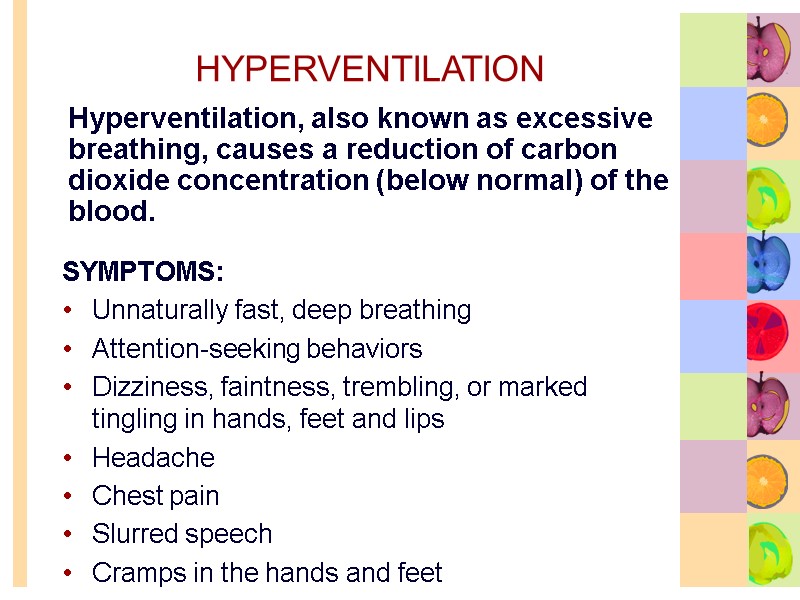
Have the hyperventilating person breathe slowly into a paper bag thats held closely around his or her mouth and nose. Remove the patient from any distressing triggers.

However today it is known that breathing into a paper bag is an improper way of giving first aid to hyperventilating patients and is no longer advised or taught.
First aid for hyperventilation. If you dont have a paper bag plain old hands will do. Simply have the person cup his or her hands over the mouth and nose and breathe in and out for at least five minutes. When a person hyperventilates emergency medical assistance is usually not necessary if.
Hyperventilation Treatment Medically Reviewed by Sabrina Felson MD on January 19 2020. Ask any bystanders to leave. Give the casualty space.
Do not advise the casualty to breathe into a paper bag as this could make the condition worse. Encourage them to seek medical advice so they can learn how to prevent and control hyperventilation or a panic attack in the future. First Aid Management for Hyperventilation.
In majority of hyperventilation cases first aid can be administered to a hyperventilating individual to reduce the symptoms. If one is experiencing hyperventilation it may be helpful to have another person assist the individual. The following steps may help increase carbon dioxide levels in the body.
What is the first aid treatment for hyperventilation. Have the hyperventilating person breathe slowly into a paper bag thats held closely around his or her mouth and nose. The person should breathe like this for five to seven minutes.
Treating hyperventilation Your main aim when treating a person who is hyperventilating is to calm them down and provide reassurance. Speak firmly but reassuringly to the person and escort them somewhere quiet and calm away from other people. Try to Recover Optimum Level of Carbon dioxide in Body.
Carbon dioxide imparts very crucial role in human body during hyperventilation we exhale a lot of co2 which leads to imbalanced blood Ph level as co2 with water form buffer solution which maintain blood Ph level to 74 muscle twitch as muscle contraction and dilation process. Set the bag aside. Breathe normally for a couple of minutes.
Repeat the steps above for up to 15 minutes. Try to breathe slowly. Focus on taking one breath every 5 seconds.
If you still hyperventilate after using Self-Care First Aid call your doctor. Tagged as first aid First Aid Resource Hyperventilation. If the persons breathing is rapid and you are certain that it is caused by emotion such as excitement give the following first aid.
Remove them from the cause eg. Away from an accident scene. Tell the person to relax and breathe slowly.
Reassurance is often enough to correct hyperventilation. First aid for hyperventilation. Remove the patient from any distressing triggers.
Attempt to control their breathing by coaching get them to copy your breathing pattern. Assess for any underlying causes. Is this an asthma or anaphylactic attack.
Obtain medical help if symptoms do not resolve. Want to learn more about first aid. How to Treat Hyperventilation - First Aid Training - St John Ambulance - YouTube.
Exercising regularly walking running bicycling etc can also help to prevent hyperventilation. Remember to stay calm if you experience any of the symptoms of hyperventilation. Explain to the patient what is happening.
Ask patient to hold their breath this will reduce the respiratory rate. Encourage slow deep breathing. Breathing through their nose will help reduce the loss of carbon dioxide.
The patient could take sips of water to help reduce the numbers of breaths taken. First aid for hyperventilation. Remove the patient from any distressing triggers.
Attempt to control their breathing by coaching get them to copy your breathing pattern. Assess for any underlying causes. Is this an asthma or anaphylactic attack.
Obtain medical help if symptoms do not resolve. When to seek treatment for hyperventilation. What is the first aid for hyperventilation.
Ask patient to hold their breath this will reduce the respiratory rate. Encourage slow deep breathing. Breathing through their nose will help reduce the loss of carbon dioxide.
The patient could take sips of water to help reduce the numbers of breaths taken. Hyperventilation occurs when an individual overly breathes. Learn the possible causes and how it is managed by reading here.
About Press Copyright Contact us Creators Advertise Developers Terms Privacy Policy Safety How YouTube works Test new features Press Copyright Contact us Creators. Paper bags have been used since the time of our great grandparents as a first aid for hyperventilation syndrome. This has been a very common procedure worldwide.
However today it is known that breathing into a paper bag is an improper way of giving first aid to hyperventilating patients and is no longer advised or taught. First Aid for Hyperventilation Calm the person down by identifying the source of anxiety and addressing it. Hyperventilation is often triggered in wilderness settings by a fear of heights equipment failures or by a minor injury that causes anxiety.
Have the person. It is easy to be so focused on an activity or goal that you do not notice a problem immediately. The first step is to notice that you are hyperventilating and to.
Chemical splash in the eye. First aid advice for breathing problems including asthma attacks croup drowning and hyperventilation. We have a wide range of first aid training courses available so you can learn what to do when faced with an emergency.
Browse our range of first aid products for everything you need to keep your workplace and community safe.